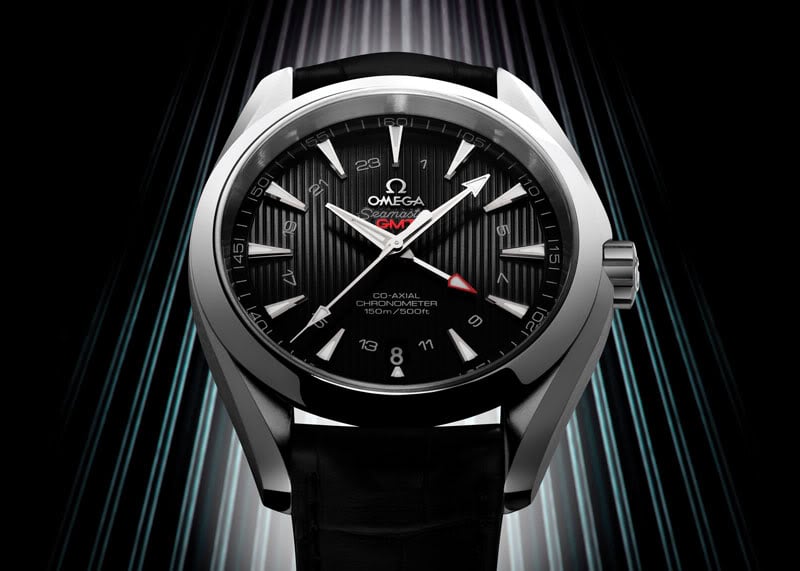Baselworld 2012 – OMEGA Seamaster Aqua Terra GMT and the Co-Axial movement explained

Three years after Omega launched the Seamaster Aqua Terra Co-Axial GMT Chronograph, Omega now launches the Seamaster Aqua Terra GMT. Visually many similarities, however without the chronograph and now with Omega’s proprietary co-axial caliber 8605/8615 GMT movement.
In terms of function it still does the same as any movement based on an ETA 2893; hour, minutes, seconds, date and a central 24 hour (GMT) hand. Technically however, the movement is much nicer. But let’s first look at its appearance.

With a diameter of 43 mm, the case is 1 mm smaller than the Aqua Terra GMT Chronograph. It is available in red gold, stainless steel or in a TwoTone version of 18 Ct red gold and stainless steel, and it comes on either a bracelet or on a black, brown or blue leather strap.
“The dial is distinguished by the teak pattern associated with the Aqua Terra collection. The vertical lines are reminiscent of the wooden decks on luxury boats.” Well, that libe of text was from the press release and I still think marketing is an interesting trade 😉 Let’s say the tuxedo striped on the dial look quite distinguished.
The applied indexes are made of 18 Ct gold, brushed and polished, and than coated with white Super-LumiNova. The hands are also 18 Ct white or red gold and coated with white Super-LumiNova. The sapphire crystal on the screw-in caseback allows a clear view of the Co-Axial movement inside.
Did you know that the GMT hand can also be used for compass orientation? When the watch is held parallel to the ground with its hour hand pointed in the direction of the sun, the GMT hand (when it is adjusted to the same time on the 24-hour GMT display) will indicate north. But this will only work in the Northern hemisphere.
The Co-Axial escapement
In the first lines of this blog, I stated the movement does more or less the same as an ETA 2893, but it is much nicer. How is it nicer you might wonder? Technically it’s much nicer and although standard ETA movements are build to last a life-time, in theory the new Omega co-axial movements should be able to last a few life-times and should be able to run at a more steady rate.
Omega uses co-axial escapements, a technical innovation they bought from the late mr. George Daniels, and they use this in conjunction with a free sprung-balance. This is different from a conventional Swiss lever escapement, which is used in ETA movements.
![]()
The watch’s rate can be adjusted by modifying the moment of inertia of the balance by means of gold regulating screws in the balance (is called a screw balance). This design avoids the disturbing effects of contact between the balance-spring and the index pins. On a normal Swiss lever escapement with index, the regulating is done by making the balance spring longer or shorter, with an index. The contact between the index and the balance spring is necessary, but comes with the risk of getting sticky because of magnetism or oil. And that’s something that has a very bad influence on the watch’s rate!
The stability of rate offered by the Co-Axial escapement is maintained over long periods of use. Furthermore, the direct impuls given to the palet, reduces friction which means that there is almost no need for lubrication. The Co-Axial calibres have long service intervals and the Seamaster Aqua Terra GMT, which is also equipped with a silicon (!!) balance and balance spring, meaning no negative influence by either gravity or magnetism.
All together Omega’s new co-axial movements are very impressive. However they do come at another price level as when Omega used run-off-the-mill ETA movements.




4 responses
Actually the compass trick works just fine in the Southern hemisphere as well.
The difference being the hand points to the south instead of north.
Never thought of that but it does sound logical. Thanx!
Finally, a nice looking un-chunky Seamaster! Price?
“In the first lines of this blog, I stated the movement does more or less the same as an ETA 2893, but it is much nicer.” This movement is categorically not based on an ETA 2893 or any other ETA movement. The Cal.8605 is an in-house Omega movement designed by Omega from the f ground up. I suggest the author changes the article to correct this gross error.